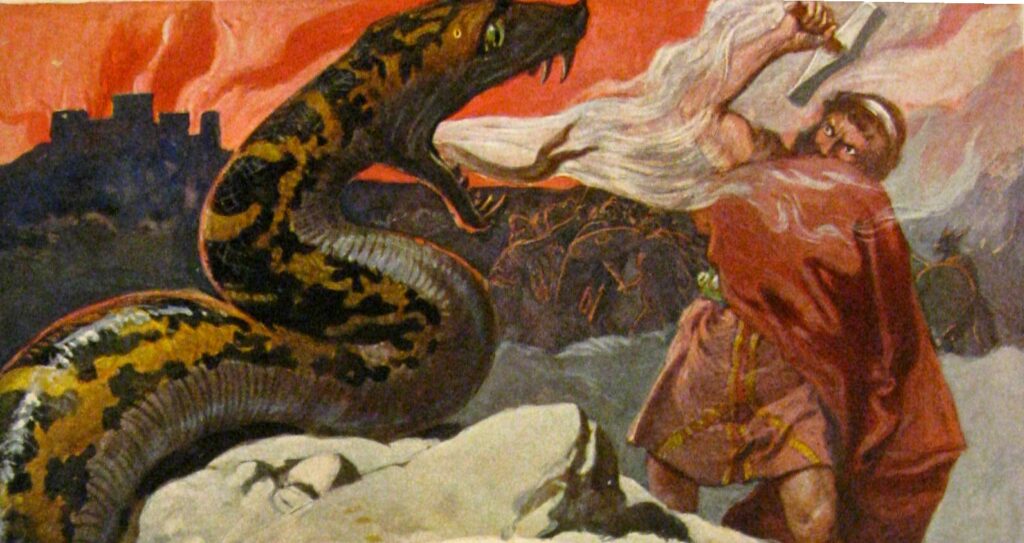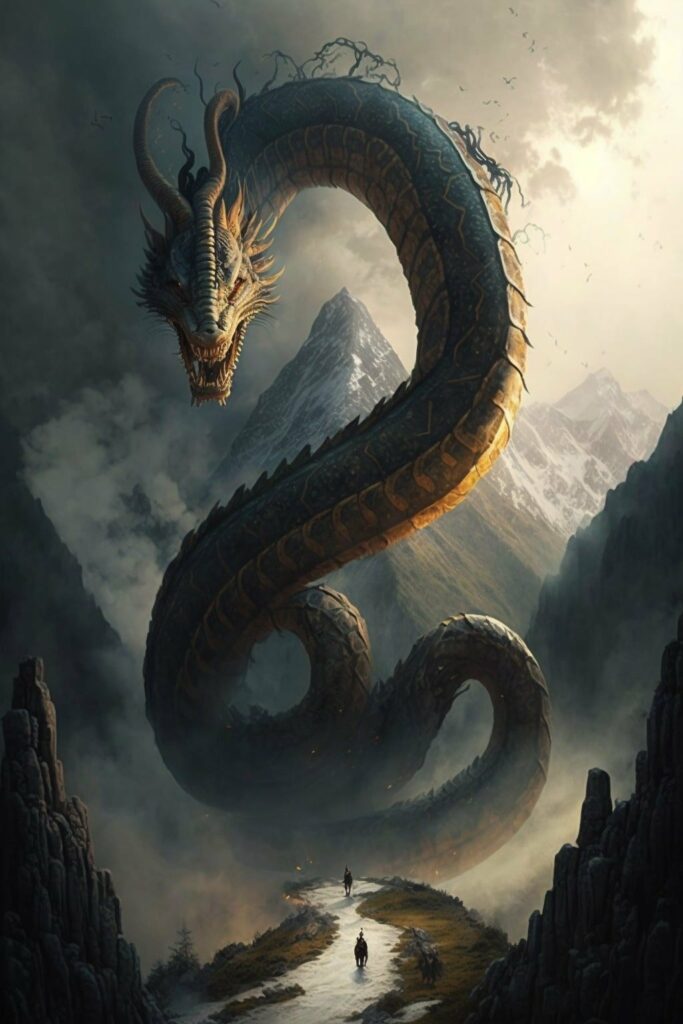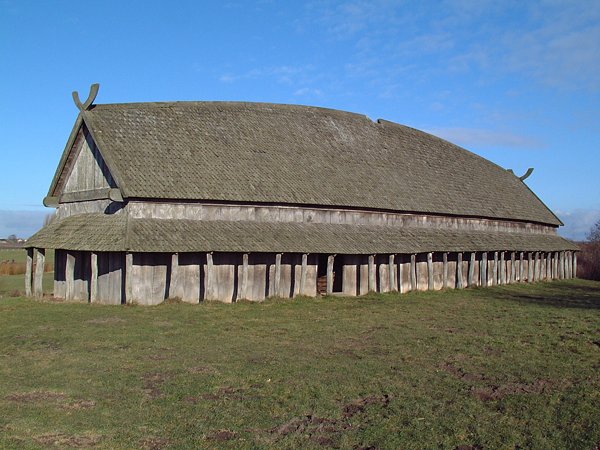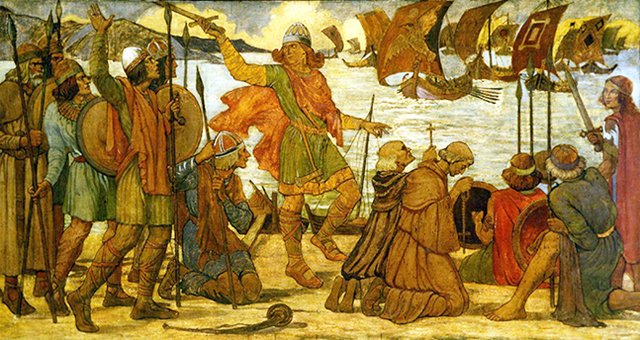Seen as a key villain in Norse mythology, the Jörmungandr was a large sea serpent resembling a worm. The Jörmungandr, also known in history as the Midgard Serpent or World Serpent, was the arch nemesis of Thor, the god of thunder.

The Birth of the Jörmungandr
The universe of Norse mythology had nine realms. These were all held on the branches of the tree called Yggdrasil. In the stories of Norse mythology, the Jörmungandr, which means “great monster” in Norse culture, was the son of Loki, the Trickster, and Angrboda, who were Jotunn, or giants.
Angrboda, whose name means “the one who brings grief,” had three monstrous children with Loki. Their children were named Jörmungandr, Fenrir, the giant wolf, and Hel, the eventual queen of the underworld.
Loki the Trickster was not well-liked by many of the gods. That, coupled with the fact that he had had children with a Jotunn was concerning for the gods. The Jotunn had a reputation for being a hostile group towards mankind and the gods.
The Norse gods agreed that something needed to be done with these monstrous children. When the god of war and death, Odin, received a prophecy that the children would grow up to challenge the gods, action was taken to banish the three creatures.
The Hel was exiled to Helheim, one of the nine realms. She then created her own domain and underworld here. The Jörmungandr was thrown into the sea, and Fenrir was taken to an island where it was bound to a rock by a magical rope.
The Rising of Jörmungandr
After being tossed into the sea, the Jörmungandr began to grow – and kept growing. Eventually, it grew to such a size that it was able to encircle the whole of Midgard (Earth).
It bit down on its tail and created an ouroboros, which refers to an ancient symbol of a snake or dragon biting on its own tail and creating a circular shape. It was said that if the Jörmungandr ever released its bite on its tail, the gods were to be aware that the world was in serious danger.
Thor and the Jörmungandr
Throughout Norse mythology, whenever the Jörmungandr was referenced, it was almost always in opposition to Thor, the god of thunder. It is not made clear how or why such a strong hatred and opposition came to be, but their stories were well connected. It is believed that the Jörmungandr likely hated Thor because of his many battles with the Jörmungandr’s mother’s relations, the giants.
One such encounter between Thor and the Jörmungandr has been called The Fishing Story. It begins with the gods planning a lavish feast in which a large cauldron is needed to brew mead, a magical elixir. Thor volunteers to visit the giant Hymir, who has such a cauldron.
Hymir slaughtered three bulls for the visit and was dismayed at the sight of Thor eating two of those bulls. Hymir tells Thor that they will fish the next day for more food and asks Thor to obtain bait for this fishing trip.
Thor slaughtered two more of Hymir’s bulls for the trip and Hymir’s annoyance with Thor grew. Out on the seas, Thor rowed the boat as the giant began to fish. To his delight, Hymir had luck and caught two whales.
As Thor rowed further and further out to sea, Hymir asserted that the dangerous Jörmungandr lurked in the deep waters and that traveling that far out was very foolish. But Thor welcomed the challenge.
Once a suitable fishing spot was located, Thor threw his bull head-baited hook into the water. It was not long before a great and strong tug came upon his line. The giant was terrified but Thor was determined.
When the head of the mighty serpent surfaced above the water, Thor’s eyes grew wide with excitement as he reached for his hammer. It was at that moment that the terrified Hymir grabbed his knife and cut the line, letting the serpent fall back into the sea.
Thor was so furious at this missed opportunity caused by Hymir, that he hurled the giant into the sea. He helped himself to the two whales that were caught that day, grabbed Hymir’s cauldron, and traveled back to the feast.

The End of Thor and the Jörmungandr at Ragnarök
The Ragnarök was a prophesied apocalypse that would include a series of catastrophic events – battles and natural disasters that would fall upon Norse mythological characters. It was at Ragnarök that Thor and the Jörmungandr met for the last time – a fight to the death.
It is said that while Thor was feasting with other gods at a gathering, the god Heimdall blew his Gjallarhorn. This could be heard in heaven, on Earth, and in the underworld. The horn symbolized the beginning of the Ragnarök.
The Jörmungandr appeared and thrashed his mighty tail, leaving a flood on the Earth as Thor grabbed his hammer and lunged at the beast. Thor was prepared for death and would not go down without a fight.
Thor called upon the heavens to unleash a dark, massive thunderstorm in which only lightning lit up the world. As Thor struck the Jörmungandr with his hammer, the beast retreated into the water only to spring back in surprise and bite Thor on the arm.
As Thor writhed in pain, he summoned a lightning strike with the force of the entire world behind it. With his hammer, he directed the strike right between the eyes of the Jörmungandr, killing the serpent.
As Thor hobbled back to land, he felt triumphant. He staggered and took a few paces forward. As the serpent’s dead body sunk back into the sea, Thor collapsed onto the Earth, leaving a large crater.
Each had killed the other. It was said that the battle between these two was so violent that it splintered the tree Yggdrasil in which the realms existed.

